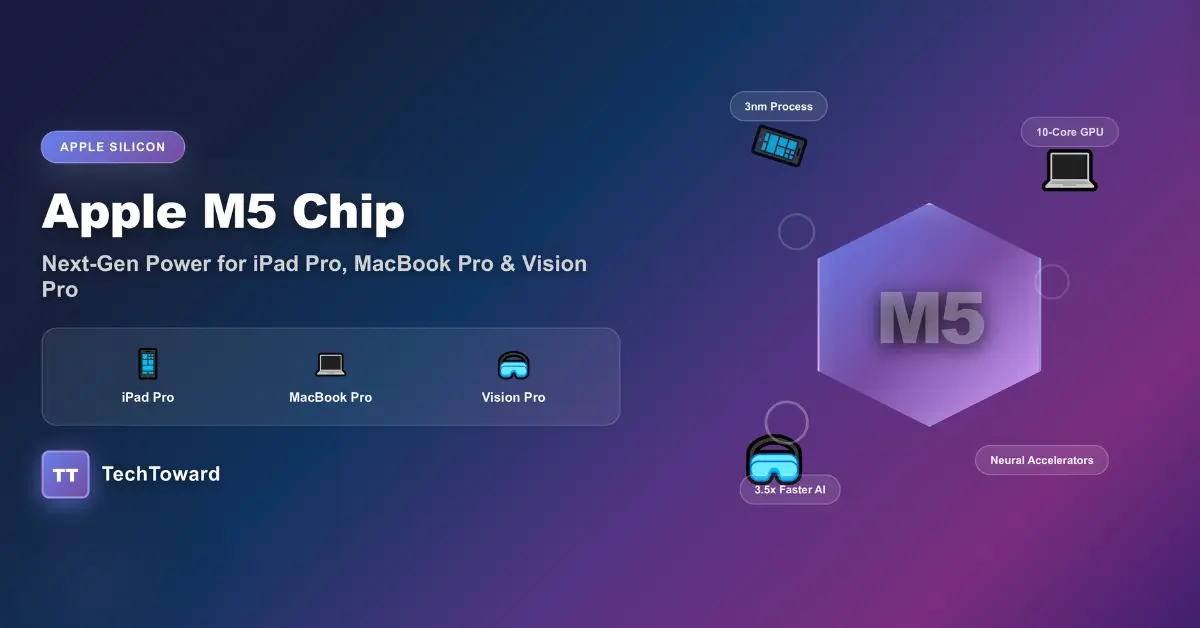Apple Unveils M5 Chip Powering iPad Pro, MacBook Pro & Vision Pro may seem like a bold technological leap, but with the right innovations under the hood, Apple makes it feel like the natural next step—elevating performance, AI capabilities, and user experience across its premium devices.
🚀 What Is the M5 Chip?
At its core, M5 is the next-generation Apple Silicon system-on-a-chip (SoC). Apple designs this chip in-house and uses it to power multiple high-end products.
Key highlights of the M5 chip:
- It’s built using a third-generation 3-nanometer (3 nm) process, meaning more transistors in the same space, with improved energy efficiency.
- It combines a 10-core CPU and a 10-core GPU, with a Neural Engine (16 cores) for AI work.
- The GPU structure now includes a Neural Accelerator in each core, making it far more efficient at AI and graphics processing.
- Its unified memory bandwidth has been increased (to about 153 GB/s), enabling faster data flow between CPU, GPU, and memory.
Put simply: M5 is not just a speed bump. It’s designed to handle the heavier demands of on-device AI, complex graphics, and pro-level workflows—all while maintaining battery efficiency.
🔍 How M5 Powers the iPad Pro, MacBook Pro & Vision Pro
Apple announced that three major products will now be powered by the M5: the iPad Pro, 14-inch MacBook Pro, and Vision Pro headset. Let’s dive into how M5 impacts each.
iPad Pro + M5: Smarter, Faster, More Capable
The iPad Pro with M5 inherits the sleek design of its predecessor but brings considerable internal upgrades.
What’s improved:
- AI performance jump: Up to 3.5× faster than the iPad Pro with M4, and 5.6× faster than the M1-based model for AI tasks.
- Graphics upgrades: The new GPU architecture (with neural accelerators) delivers smoother 3D rendering, improved ray tracing, and better visuals in demanding apps.
- Memory & storage: The 256 GB and 512 GB versions now begin with 12 GB unified memory, offering more breathing room for multitasking and large workloads.
- New wireless chip (N1): Enables Wi-Fi 7, Bluetooth 6, and Thread (for smart home integration).
- Faster cellular (C1X modem): On cellular models, data performance is up to 50% faster.
- Ships with iPadOS 26, which includes smarter multitasking, AI-based features, and fresh UI components.
Use-case snapshot: Imagine you’re editing a 4K video, running AI-driven image enhancements, and having multiple apps open simultaneously—this new iPad Pro can handle it fluidly, thanks to M5’s horsepower.
14-inch MacBook Pro + M5: The Pro Tool Gets Sharper
Apple’s new MacBook Pro (14-inch) retains its outward form factor but gets a serious internal boost thanks to M5.
Key enhancements:
- AI workload boost: M5 brings up to 3.5× faster AI performance over previous models.
- Graphics uplift: Claims of up to 1.6× better graphics performance compared to M4-based machines.
- Battery life: Apple advertises up to 24 hours, making the device more capable for all-day productivity.
- Faster storage: SSD read/write speeds are improved, ideal for handling large media files, compiling code, or rendering.
- Supports macOS Tahoe, which introduces deeper AI integration and enhanced workflows.
Use-case snapshot: If you’re a developer training small AI models locally, or a creative editor juggling multiple 8K video streams, this MacBook Pro now better bridges the performance gap between desktop workstations and mobile devices.
For deals on Apple laptops, check out this roundup of top MacBook Air 2025 deals.
Vision Pro + M5: Smarter Spatial Computing
The Vision Pro mixed-reality headset gains a refreshed design and brains with the M5 chip.
Major upgrades:
- Sharper visuals: It can render ~10% more pixels on the micro-OLED displays, resulting in crisper text and finer detail.
- 120 Hz refresh rate: The headset can push up to 120 Hz for smoother interactions and reduced motion blur.
- Battery life: General usage is up to 2.5 hours, and 3 hours for video playback.
- Comfort upgrade: A Dual Knit Band is included—a softer, adjustable strap engineered for better balance and fit.
- Ships with visionOS 26, opening doors to new spatial apps, generative AI integration, and advanced Persona / widget experiences.
Use-case snapshot: Whether you’re designing in spatial apps, watching immersive content, or using your Mac in virtual “rooms,” the M5-powered Vision Pro aims to deliver a smoother, more responsive experience.
Want a hands-on review of this upgraded headset? See our Vision Pro 2025 review where we examine whether it’s worth the massive price tag.
⚙️ Advanced Insights & Technical Deep Dive
If you’re a power user, developer, or tech enthusiast, here are some deeper takes on what M5 brings to the table:
Neural Accelerators in Every GPU Core
One of the most distinctive architectural changes: each GPU core now has an embedded Neural Accelerator. This means AI workloads—like running neural nets, diffusion models, or inference tasks—can be offloaded to the GPU in an optimized way, reducing load on the CPU and improving throughput.
This design marks a shift: instead of treating AI as a separate domain (handled by a Neural Engine), Apple now weaves it more deeply into the graphics pipeline.
Focus on On-Device AI & Privacy
By giving every device a more capable AI engine, Apple further emphasises on-device processing—running AI models locally, without relying on cloud inference. This improves latency, privacy, and offline capability.
Memory Bandwidth & Unified Memory
Increasing unified memory bandwidth to ~153 GB/s helps prevent bottlenecks when the CPU, GPU, and Neural Engine are all accessing the same data. This synergy is especially useful for pro workflows like video rendering, large model inference, and real-time effects.
Power Efficiency & Thermal Constraints
Moving to a 3 nm process allows more performance for the same—or ideally, lower—power usage. That’s key for tablets and headsets with tight thermal and power envelopes. While Macs have more headroom, the improvements benefit all devices.
🛠 Step-by-Step: Choose the Right M5-Equipped Device for You
If you’re considering upgrading or investing in one of these M5-powered devices, here’s a helpful decision guide:
- Define your primary use-case
- For artistic work, video editing, local AI modeling → MacBook Pro
- For mobility with pro-grade capability → iPad Pro
- For spatial computing, AR/VR experiences → Vision Pro
- Match specs with workflows
- If you use large datasets, use 512 GB / 1 TB configurations
- Heavy 3D rendering or GPU-centric apps? Opt for higher memory + GPU throughput
- Don’t neglect software support
- For iPad, ensure critical apps support iPadOS 26
- On Mac, check if your development tools / creative suites are optimized
- Vision Pro: Familiarize yourself with visionOS spatial UX
- Consider battery / portability trade-offs
- MacBook: Good for all-day work
- iPad: Lightweight, but workflow depends on apps
- Vision Pro: Battery usage is limited; ideally used near power or for shorter sessions
- Future-proofing
- M5 is cutting-edge now, but Apple will likely roll out M5 Pro / Max (or successor) in later years
- Ensure the model you buy has enough headroom (memory, storage) for evolving demands
📊 M5 vs M4: Performance at a Glance
| Metric / Workload | Improvement over M4 (approx.)* |
| Peak GPU compute for AI | ~4× higher |
| Graphics performance (non-AI) | Up to ~45% uplift |
| Multithreaded CPU tasks | ~15% faster |
| Unified memory bandwidth | ~30% increase |
| AI tasks (iPad): image gen, video mask | 3.5× / 5.6× boost over older chips |
| 3D rendering / ray tracing | 1.5× or more |
| Battery / power envelope | Better efficiency |
* These are vendor-provided claims. Real-world performance may vary depending on thermal conditions, software optimization, and use patterns.
🧩 Real-Life Example: Workflow with M5 iPad Pro + MacBook Pro
Let’s imagine a designer, Sarah, working on a mixed-reality app that uses computer vision and spatial effects:
- Sketching & prototyping
- She begins in iPad Pro, sketching UI and mockups with Pencil.
- She also runs on-device image generation in an AI app, thanks to M5’s Neural Accelerators.
- She begins in iPad Pro, sketching UI and mockups with Pencil.
- Testing & simulation
- She exports the assets to her MacBook Pro, where she compiles shaders, runs simulations, and tests performance.
- AI scripts (e.g. object segmentation) run locally with high throughput.
- She exports the assets to her MacBook Pro, where she compiles shaders, runs simulations, and tests performance.
- Experience preview in spatial domain
- If she owns a Vision Pro, she can preview immersive scenes directly in spatial 3D, viewing layout, lighting, and interaction in real space.
- She tweaks parameters, sends updates to iPad / Mac, and iterates.
- If she owns a Vision Pro, she can preview immersive scenes directly in spatial 3D, viewing layout, lighting, and interaction in real space.
This closed-loop workflow—sketch → compute → preview—benefits greatly when each device is fast, efficient, and coherently integrated.
Frequently Asked Questions
Q: When will M5-powered devices be available?
A: Preorders began immediately after the announcement, and devices ship in late October 2025.
Q: Does M5 run cooler or use less power than M4?
A: Yes, thanks to its use of a more efficient 3 nm process and architectural improvements, M5 offers better energy-per-compute performance. However, real thermal behavior will depend on device design, workloads, and cooling systems.
Q: What kind of tasks benefit most from M5?
A: Tasks involving AI inference, graphics rendering, 3D/AR workloads, video editing, and local ML model execution gain the most. Ordinary tasks (web browsing, email) will feel smoother, but not dramatically different.
Q: Will older apps break on devices with M5?
A: Apple ensures backward compatibility. Most apps should work, but developers are encouraged to optimize for the new architecture to fully benefit from M5’s neural and graphics features.
Q: Is M5 the last of the line, or will Apple continue with Pro / Max variants?
A: Apple has a history of expanding chip tiers. It’s likely we’ll see M5 Pro, M5 Max, or a future M6 in due course.
Conclusion
With the rollout of the M5 chip, Apple has firmly doubled down on the notion that future computing is intelligent, integrated, and on-device. Whether you’re a creative professional, developer, or immersive experience builder, the leap in power gives you tools to push boundaries without being tethered to cloud compute or settling for sluggish workflows.
If you’re considering an upgrade or new investment, now is a compelling time:
- Preorder or explore the M5-powered iPad Pro for mobile AI, media editing, and next-gen multitasking
- Get hands-on with the 14-inch MacBook Pro (M5) if performance and flexibility are your priorities
- Try the Vision Pro with M5 to experience spatial computing at its latest evolution
👉 Here’s what you can do next: Visit Apple’s official site to compare configurations, read detailed specs, or pre-order your preferred model. And if you’d like help choosing which one fits your workflow best, drop me a line—I’ll help you pick the perfect one.


